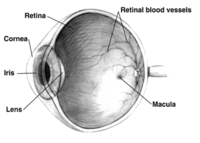
Photo from wikipedia
Human Retina In the rodent retina, intrinsically photosensitive retinal ganglion cells (ipRGCs) entrain circadian rhythms, modulate mood, and signal pupillary accommodation. Such responses are light-driven but not image-based. Working with… Click to show full abstract
Human Retina In the rodent retina, intrinsically photosensitive retinal ganglion cells (ipRGCs) entrain circadian rhythms, modulate mood, and signal pupillary accommodation. Such responses are light-driven but not image-based. Working with donated human organ tissues, Mure et al. used electrophysiological approaches to identify ipRGCs in the human retina. The human retina has more cones than the retinas of nocturnal mice and rats. Differences in sensitivity, latency, and duration of responses identified three subtypes of human ipRGCs. Science , this issue p. [1251][1] [1]: /lookup/doi/10.1126/science.aaz0898
Journal Title: Science
Year Published: 2019
Link to full text (if available)
Share on Social Media: Sign Up to like & get
recommendations!